Care and husbandry for green tree pythons.
The green tree python (Morelia viridis) is a fascinating species to maintain and reproduce in captivity. Most of the old stigmas about green tree pythons being difficult to keep alive have faded due to good husbandry information developed from decades of combined experience and an excellent supply of healthy, captive-bred specimens. Hobbyists widely keep chondros (pronounced kon-drose, from the original genus Chondropython) these days.
Mostly Straightforward Husbandry
Although somewhat specialized, green tree python care is pretty straightforward and not too difficult. Two misconceptions are common. The first is that this snake’s husbandry is very complicated, and the animals are quite delicate. The second is that claims of specialization have been exaggerated and that green tree pythons can be maintained like any other snake. Perhaps the most common mistake that new keepers make is that they provide a habitat most convenient (and least expensive) for themselves rather than providing an enclosure that allows the correct environment for these beautiful pythons.
Green tree pythons need a temperature gradient, moderate humidity and security. Let’s discuss these requirements in detail. In my experience, the best green tree python enclosure is one constructed of waterproof materials and oriented horizontally rather than vertically. Although it is common to see arboreal snakes kept in tall, vertically oriented cages, most snakes select security over optimum temperature if they are forced to choose. Green tree pythons often choose to roost on the highest perch in their enclosures, so in a tall, narrow cage the thermal gradient will normally be unused by the snake.
Providing a horizontal temperature gradient allows the snake to thermoregulate while still using a high perch. To accomplish this important condition, I install a radiant heat panel at one end of the cage and use a proportional thermostat to regulate the panel’s output. This arrangement creates a cage environment that ranges from 78 to 88 degrees Fahrenheit at perch height.
Cage humidity also is an important factor in green tree python husbandry, but the exact percentage is not critical. Daily misting with a pump sprayer filled with clean, drinkable water provides adequate humidity. Experience helps snakekeepers match the correct amount of spraying with the cage ventilation and ambient local humidity. Avoid excess cage ventilation; drafts can cause respiratory problems, and cages that dry too quickly after spraying produce dry sheds that are difficult to remove.
Note humidity is the measure of water vapor in the air, not how wet the cage is. A wet floor that does not evaporate is not contributing any measurable amount of humidity, and it may also lead to the growth of bacteria and mold.
Click image to enlarge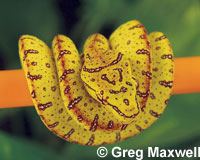 Blaze-Yellow. |
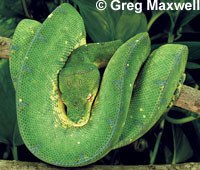 Wamena. |
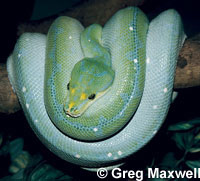 "Hormonal" Blue. |
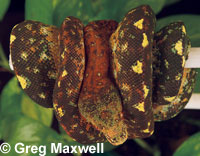 Calico. |
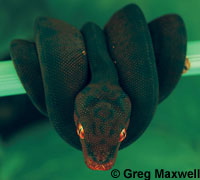 Black. |
Secure the Enclosure
Maintain green tree pythons in cages measuring 36 to 48 inches long, 24 inches high and 18 to 24 inches deep. Providing more height is unnecessary, and doing so introduces complications, such as a cage floor that is too cool. Daily misting is normally a part of green tree python husbandry, and a cool floor often stays wet, which can cause mold to form. Cages 24 inches tall allow heat from the panel to reach the floor and help the substrate evaporate moisture, creating humidity. Cages less than 36 inches long make it difficult to establish a thermal gradient. Smaller cages also contribute to snake lethargy.
The cage should have a glass front and solid walls, which provide some of the security needed by green tree pythons. The back and sides of glass or acrylic tanks should be covered or painted, so these somewhat nervous animals do not feel exposed. A dark interior color in the cage is highly preferable to white; this also helps the chondro feel secure. I have seen specimens housed in plain white cages that lash out in fear when approached, but they became almost tame when moved to a darker cage.
My cages are made from medium-density fiberboard and laminated with dark green vinyl inside. I prefer sliding glass doors to hinged doors, but either will work.
The enclosure should be fitted with a secure perch roughly the same diameter as its occupant’s body. PVC pipe is inexpensive and readily available, but I find that real wood perches look much nicer. I use perches cut from live maple trees. Avoid toxic wood species, such as walnut and wild cherry, and wooden dowel rods from the hardware store because they mildew quickly. Make sure to install perches in such a way that they will not shift or rotate under the snakes’ weight. Place one end of the perch about 6 to 8 inches below the heat panel to provide a basking area.
A full-spectrum light shows off the colors of your green tree pythons nicely, but keep lighting subdued, and avoid high wattage elements that can overheat the cage. I use timers in my cages and snake room to establish a 12-hour photoperiod.
Substrate should be absorbent but not smear or become messy. I like cypress mulch, and newspaper works very well but does not look as nice. A water bowl should be provided on the floor at the cool end of the cage. Plants finish the cage’s appearance and help provide cover for the snakes. I hang silk pothos vines from the top of my cages, and the snakes really enjoy the shadows provided by the broad leaves.
The cage design described above works well for housing adult tree pythons. However, a heated rack with plastic tubs is ideal for raising green tree python neonates and yearlings. Fit tubs with small plastic perches, a small water dish and newspaper substrate. The snakes thrive in them and love the security the translucent tubs provide. Although such a setup does not offer maximum visibility for the keeper, it bears repeating that the best policy is to give the animals what they need.
Some neonates won’t eat in a display cage, and feeding neonates can be difficult enough without this additional factor. Also note that under no circumstances should neonates be handled or sexed until they are at least a year old. Handle adults based on their individual temperaments.
Health Issues
The two most common health issues (other than dry sheds, which result from inadequate humidity) are respiratory infections and rectal prolapse.
The causes of respiratory infections are not always known, and specimens can develop symptoms under seemingly ideal conditions. Symptoms include a raspy, mucous sound when the snake inhales, coughing and perching with its head tilted back. Avoiding improper temperatures, drafts and stress are the best defenses. Consult your veterinarian for treatment; I use Baytril to effectively treat these infections.
Rectal prolapse is frightening but usually looks much worse than it is. Most cases are treatable if caught early, so beginning each day with an inspection of your animals is a good idea. Treatment includes keeping the swollen tissue moist to prevent desiccation (drying out), and reinserting the tissue back into place. Your vet is the best person to perform this, though I treat cases myself. Place the recovering snake in a warm, humid tub with no perch for a few days, and withhold food for two weeks. Then feed very small prey until a normal bowel movement is observed. Stress, obesity and lack of muscle tone are probable causes of prolapses. Like respiratory infections, it can occur under seemingly ideal conditions with no apparent cause.



